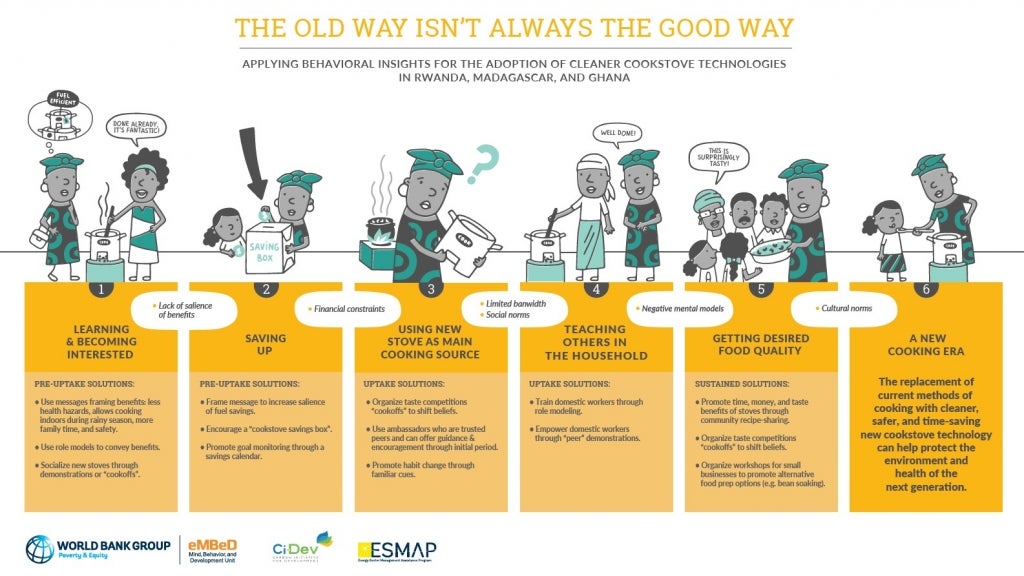 Photo of women cooking/SEforAll
Photo of women cooking/SEforAll
How did you learn to cook? Like many people, you may have grown up helping your parents or grandparents prepare meals and picked up a few tricks from friends. Culture and community influence not only what we cook but how we cook. The World Bank is using such insights into human behavior to encourage low-income households to shift from traditional wood — or charcoal-burning cookstoves to more efficient cookstoves fueled by cleaner energy sources. Despite progress, the transition has been far from consistent or sustainable.
While the benefits of upgraded cookstoves are multiple — less indoor air pollution, natural resource preservation, and better health and quality of life for those who use them — so too are the barriers. Price incentives and technology improvements have helped make clean cookstoves easier to own and operate , but purely economic and technological interventions often do not consider the complex human side of decision-making. Societal and cultural norms and biases also play an important role in the decision to use cleaner cookstoves.
To better understand how households perceive clean energy options, the World Bank’s Carbon Initiative for Development (Ci-Dev) and its Mind, Behavior, and Development Unit (eMBeD) teamed up to conduct behavioral diagnostics in rural and peri-urban communities of Rwanda, Madagascar, and Ghana. By looking at the challenge through a behavioral science lens, we aimed to identify feasible, scalable, and low-cost actions to address the societal and cultural barriers holding back clean energy choices in low-income households.
Understanding perspectives and preconceptions
Over 12 months, we collected extensive qualitative data through interviews with 55 households, an additional 34 participants across six focus group discussions, and six marketplace observations in total across the three countries. The data helped trace a potential user’s decision-making journey toward adopting and using an improved cookstove as illustrated in the infographic below. These are our three takeaways:

- Benefits of clean cooking are interpreted differently on the ground. The international donor community often promotes clean cookstoves for their long-term health benefits (such as reduced rates of household air pollution), but that message does not reach households as expected. Instead, they respond to the more tangible cues of cleaner air, such as less itchy eyes and less soot on the ceiling. But more important than the health benefits, households value the additional family time that clean cookstoves afford them in the morning and evening.
- Clean cooking is seen as an addition to traditional cooking methods, not a replacement . Many households consider improved and clean cookstoves only suitable for quick applications like boiling water and reheating food so as not to waste quick-burning fuel (easily seen as burning money). They hold firm that staple foods like dry beans, beef, and pork feet are best slow cooked with a traditional charcoal stove or, in rural areas, a three-stone fire. Stove stacking, where households use both clean and traditional cooking methods, is holding back a full transition to sustained use of improved and clean cookstoves.
- Cooking with a clean cookstove is considered a high-skill activity beyond domestic workers’ abilities. Domestic help is common in households across the income distribution, but a lack of confidence in domestic workers’ abilities can lead to reluctance in letting them cook using the cleaner stoves. Limited training and experience compound the problem, making operator errors all the more likely. This reinforces biases of workers’ skill levels and lessens the use of clean cooking technology.
Changing approach to change minds
Moving forward, we are developing and implementing solutions informed by behavioral science. For example, we are enlisting the support of well-respected role models to help motivate change. In Madagascar, a campaign headed by the First Lady to promote the environmental benefits of ethanol cookstoves led to huge success. Rural, low-income households were receptive to her direct outreach and support. They internalized her pro-environment message and purchased more ethanol cookstoves.
We are also looking at ways households can develop energy-efficient cooking practices without sacrificing taste or tradition. In Rwanda, beans are a household staple and traditionally slow-cooked over charcoal. Household cooks we interviewed had not considered soaking beans overnight to save cooking time and, importantly, cooking fuel. To build this habit, bean soaking could be anchored to a specific point of an established daily routine. For example, part of the evening meal preparation could be filling a pot with dried beans and water for soaking overnight and cooking the next day. This way, beans are consistently being prepared for daily, quick cooking on an improved or cleaner cookstove.
We all hold dear the cooking knowledge and recipes passed on from our elders, but food just like grandma or mom used to make can be achieved in cleaner, more energy-efficient ways. By better understanding cultural experiences, cooking practices, and the factors underlying perceptions and preferences, we can promote behavioral change and improve lives through clean energy options.




Join the Conversation